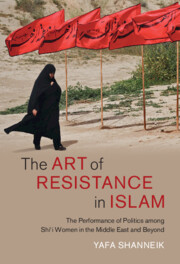 The Art of Resistance in Islam
The Art of Resistance in Islam Book contents
- The Art of Resistance in Islam
- Cambridge Middle East Studies
- The Art of Resistance in Islam
- Copyright page
- Contents
- Figures
- Preface
- Note on Transliteration
- Introduction
- 1 Trajectories of Shiʿis in the Gulf and Their Presence in Europe
- 2 The Rites of Mourning within Shiʿi Islam
- 3 Performing the Sacred
- 4 Aestheticization of Politics
- 5 Fatima’s Apparition
- 6 The Power of the Word
- 7 Conclusion
- Bibliography
- Index
- Books in the Series
3 - Performing the Sacred
Emotions, the Body, and Visuality
Published online by Cambridge University Press: 06 January 2022
- The Art of Resistance in Islam
- Cambridge Middle East Studies
- The Art of Resistance in Islam
- Copyright page
- Contents
- Figures
- Preface
- Note on Transliteration
- Introduction
- 1 Trajectories of Shiʿis in the Gulf and Their Presence in Europe
- 2 The Rites of Mourning within Shiʿi Islam
- 3 Performing the Sacred
- 4 Aestheticization of Politics
- 5 Fatima’s Apparition
- 6 The Power of the Word
- 7 Conclusion
- Bibliography
- Index
- Books in the Series
Summary
The chapter discusses the various forms of the performativity of the political and examines the enactment of the Karbala paradigm through theatrical performances (tashabih) and the ritual of mashy ‘ala al-jamur (walking on hot coals). The individual and collective emotions that are generated through tashabih and their effect on the body play an important role. The emotional pain caused by the oral narration together with the visual performance and enactment of historical events are interwoven with the actual physical pain that is self-imposed through Shi‘i ritual practices. The reciprocal relation between emotions, the body, and visuality is discussed in more detail through examining this particular act of resistance.
Keywords
- Type
- Chapter
- Information
- The Art of Resistance in IslamThe Performance of Politics among Shi'i Women in the Middle East and Beyond, pp. 96 - 127Publisher: Cambridge University PressPrint publication year: 2022
